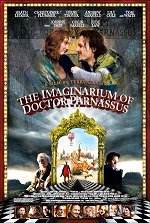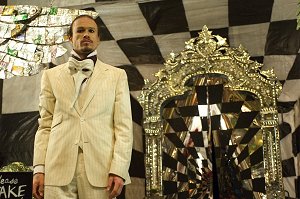 |
|
At The Picture Show
|
January 2010
Step right up
Gilliam is back in gleeful, witty form in the frenzied 'Imaginarium of Doctor Parnassus'

The Imaginarium of Doctor Parnassus
Sony Pictures Classics
Director: Terry Gilliam
Screenplay: Terry Gilliam and Charles McKeown
Starring: Heath Ledger, Christopher Plummer, Tom Waits, Lily Cole, Andrew Garfield, Verne
Troyer, Johnny Depp, Jude Law and Colin Farrell
Rated PG-13 / 2 hours, 2 minutes



 (out of four)
(out of four)
A Terry Gilliam movie is less a piece of linear storytelling than a concoction of ideas shaped into
something resembling a plot. This is more of a compliment than a slight, I assure you. The
results can be either intoxicating or frustrating, but you're certainly always aware you're
watching a one-of-a-kind filmmaker at work.
His mind always seems to be racing, a trait reflected in his films - often wild, frantic, messy.
When he's at his best, we see those characteristics as symptomatic of the frenzied, chaotic
mindset in which his characters so often find themselves - particularly, as is usually the case
with a Gilliam movie, in a world spiraling out of control.
 Oh yes, there's a method behind the mess. Even when his
work loses all control . . . well, we can kinda forgive him, if only because his visual conceptions
and setpieces are too brilliant to ignore. Forget structure, right? Show me more of that!
Oh yes, there's a method behind the mess. Even when his
work loses all control . . . well, we can kinda forgive him, if only because his visual conceptions
and setpieces are too brilliant to ignore. Forget structure, right? Show me more of that!
And so he does - and those who can keep up are usually rewarded. His latest effort, The
Imaginarium of Doctor Parnassus, epitomizes all we have come to expect from Gilliam. It is a
messy mass of ideas that comes together in a deliriously inventive take on the age-old battle
between good and evil, on the age-old battlefield of reality vs. imagination. Gilliam's
sensational gift for visual invention, the outlandish absurdity of his satirical jabs, his weakness
for indulgence, his loose interpretation of structure - it's all here.
Who else but Gilliam would feature a setpiece of dancing policemen singing, Python-style, a
song called "We Love Violence"? Where else would you find an entire realm set inside the
imagination with this much visual detail and stylistic contortion?
Of course, for some, that will be beside the point. I've heard it argued that The Imaginarium is
too confusing, difficult (impossible!) to follow, hard to understand.
 Now, Gilliam has never been the cleanest storyteller in the
world - but what exactly about this film that's all that difficult to follow is beyond me. It
basically covers a series of wagers between the titular Dr. Parnassus (Christopher Plummer) and
the Devil - going by the moniker, "Mr. Nick" - played by the one and only Tom Waits. Mr.
Nick found Parnassus as a monk hundreds of years ago and offered him a bet, and he's been
stringing him along ever since - changing the stakes, going double-or-nothin', adding a new
wrinkle or two.
Now, Gilliam has never been the cleanest storyteller in the
world - but what exactly about this film that's all that difficult to follow is beyond me. It
basically covers a series of wagers between the titular Dr. Parnassus (Christopher Plummer) and
the Devil - going by the moniker, "Mr. Nick" - played by the one and only Tom Waits. Mr.
Nick found Parnassus as a monk hundreds of years ago and offered him a bet, and he's been
stringing him along ever since - changing the stakes, going double-or-nothin', adding a new
wrinkle or two.
Long ago, he offered the vain Parnassus the gift of immortality - in exchange for his firstborn
come the age of 16. It's now modern-day, and Parnassus is a depleted old drunk running a
traveling carnival show that's struggling to stay afloat. At the center of the stage is the looking
glass, through which inhabitants' imaginations come to life - with Parnassus' help, of course.
But nothing imaginary is on his mind right now, for his darling daughter Valentina (Lily Cole),
is just days away from her 16th birthday - and Mr. Nick is hovering to claim his prize. But it
couldn't be as simple as all that, right? After all, this is the Devil we're talking about here. The
Devil knows ol' Parnassus is always up for another wager. And so Mr. Nick shows up - with
Waits' indelible voice, that sly comic timing, that delectably diabolical charm, all dressed up in a
black tux, overcoat and a bowler cap - and offers Parnassus another shot: a battle for souls,
through the Imaginarium. First to five wins.
The wrinkle in this scenario is the sudden appearance of a mysterious stranger named Tony
(Heath Ledger), an apparent amnesiac who nonetheless seems to be hiding something. Valentina
and her traveling show co-star, Anton (Andrew Garfield), save Tony's life one night after
finding him hanging by his neck from underneath a bridge.
 Tony reinvents the show, offering volunteers the chance to
enter the Imaginarium - where, they discover, they will be forced to make the ultimate choice
between the temptations of the good Dr. Parnassus, and the sinister Mr. Nick. Their souls are on
the line and they don't even know it.
Tony reinvents the show, offering volunteers the chance to
enter the Imaginarium - where, they discover, they will be forced to make the ultimate choice
between the temptations of the good Dr. Parnassus, and the sinister Mr. Nick. Their souls are on
the line and they don't even know it.
Accompanying each client on the other side is Tony himself. It is here that Ledger's untimely
death must be mentioned. When he passed, he had completed the bulk of filming, but hadn't yet
started work on the fantastical sequences. Through a lucky screenplay loophole, the
Imaginarium gives the character the opportunity to change appearance - at the imaginary whims
of the people he's accompanying. Filling in as the Imaginarium versions of Tony are Jude Law,
Colin Farrell and a little-known newcomer named Johnny Depp.
The way Gilliam utilizes the Imaginarium sequences is an impressive feat in and of itself.
Rather than trying to pare down his visual choices for budgetary reasons or attempting in vain to
make extensive CGI look photorealistic, he goes big - while emphasizing the very artificiality of
the imaginary worlds his characters have created. Some of the compositions are reminiscent of
his animated work on Monty Python - heightened and distorted perspectives, splashes of hyper-realistic color, comedic asides and flights of fancy.
All three substitute Tonys serve the story well as we gradually learn more and more about his
character and the role he plays in the ultimate fate of Parnassus and his precious Valentina.
 Ledger and Plummer are excellent, as expected, and Farrell
does a stellar job with the meatiest role of Ledger's three fill-ins. But the standout performance
belongs to Waits - not just a peerless musician but a fine actor in his own right (Down by Law,
Short Cuts, Coffee and Cigarettes). He always seemed like a perfect choice for the role, and his
funny, sardonic and idiosyncratic take on the darkest of all dark characters more than meets the
expectations.
Ledger and Plummer are excellent, as expected, and Farrell
does a stellar job with the meatiest role of Ledger's three fill-ins. But the standout performance
belongs to Waits - not just a peerless musician but a fine actor in his own right (Down by Law,
Short Cuts, Coffee and Cigarettes). He always seemed like a perfect choice for the role, and his
funny, sardonic and idiosyncratic take on the darkest of all dark characters more than meets the
expectations.
Gilliam's films have always worked best when their fantastical elements were combined with the
farcical, mischievous wit we've seen since his Python days. That is on full display here - and
it's worth noting that he re-teamed with writer Charles McKeown, with whom he collaborated
on the screenplay for his 1985 masterpiece, Brazil.
The Imaginarium of Doctor Parnassus is not perfect and even hits something of a narrative lull
early on, but it grows more and more exhilarating as it goes along, Gilliam's own imaginarium
swallowing us whole.
Read more by Chris Bellamy